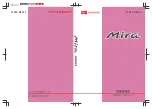
Tire Information
Tire Inflation
Warning
Using underinflated or overinflated tires will increase the risk of accident and
injury.
To ensure your safety while driving, please check the tire pressure regularly. When
checking the tire pressure, make sure the tires are cold (the tire temperature is the
same as the ambient temperature or the vehicle has not been moved for three
hours after driving). The recommended cold tire inflation pressure label is located
on the frame of the driver’s side door. If the tire is hot, the tire pressure is generally
0.3 bar higher than that of a cold tire.
Overinflation will affect your comfort while driving, damage tires, especially on
rough roads, and cause blowouts in severe cases. This may lead to unexpected
loss of vehicle control and increased risk of injury. Underinflation will cause
uneven tire wear, affect the vehicle handling, and result in abnormal energy
consumption.
You can inflate the tires with the tire inflator in the emergency kit. To inflate a flat
tire:
1. Park the vehicle on a safe road, put on the reflective vest and set up the
warning triangle properly.
2. Open the emergency kit cover in the trunk to take out the tire inflator.
Emergency Rescue
357
Summary of Contents for ES6 2022
Page 2: ......
Page 69: ...1 2 3 4 5 6 7 Travel with a Partner 67...
Page 286: ...Lock 284...
Page 360: ...Emergency Rescue 358...
Page 365: ...Emergency Rescue 363...
Page 369: ...Emergency Rescue 367...
Page 383: ...Emergency Rescue 381...
Page 385: ...Emergency Rescue 383...
Page 391: ...Emergency Rescue 389...
Page 395: ...Emergency Rescue 393...
















































